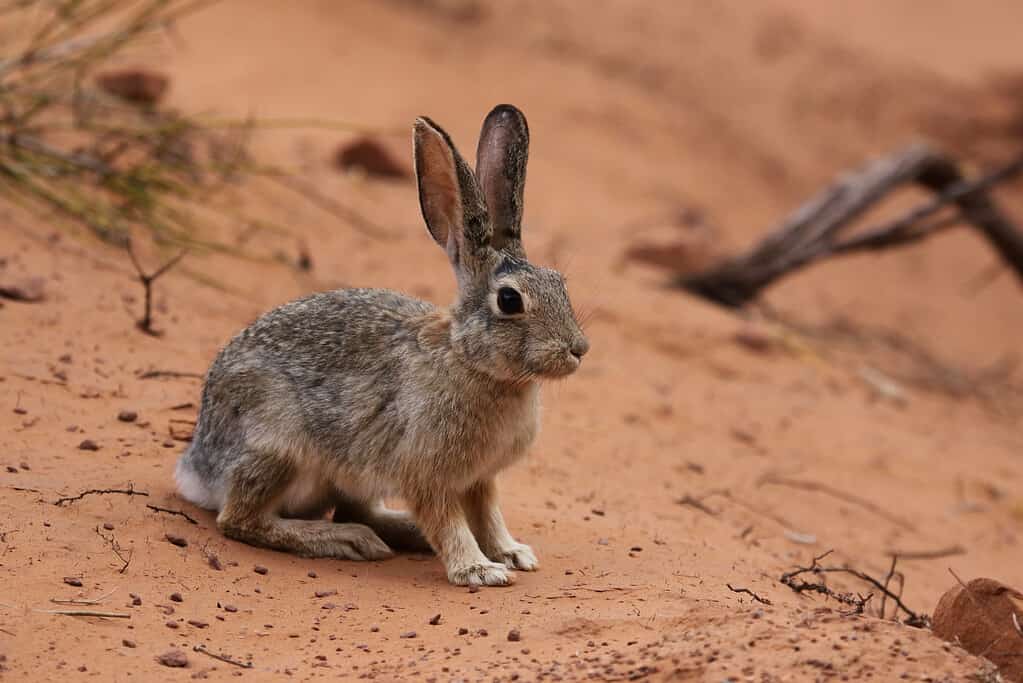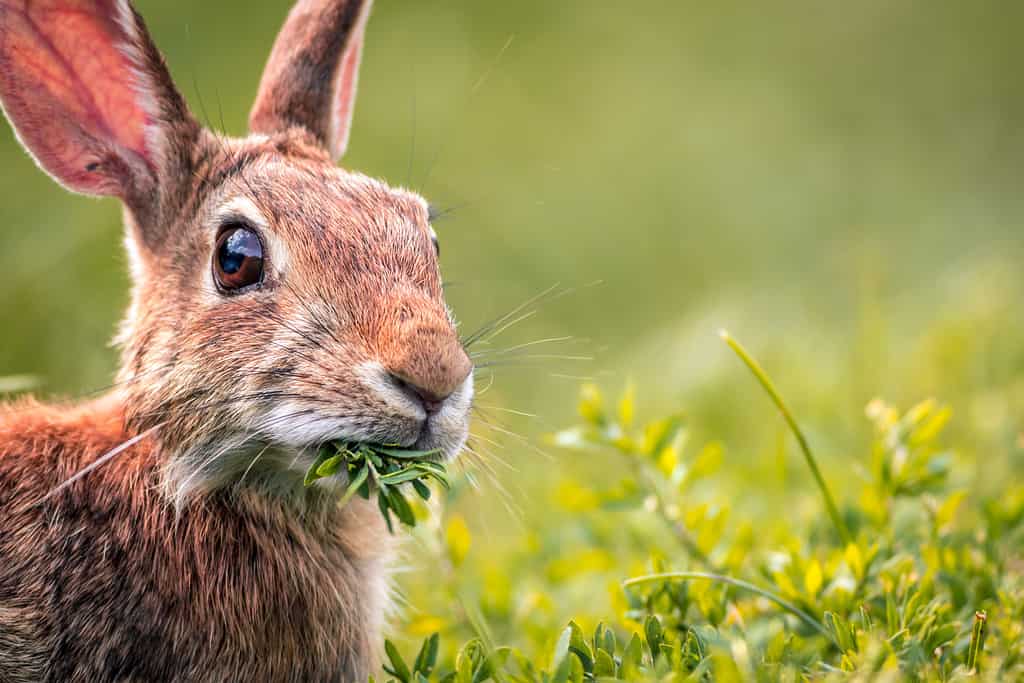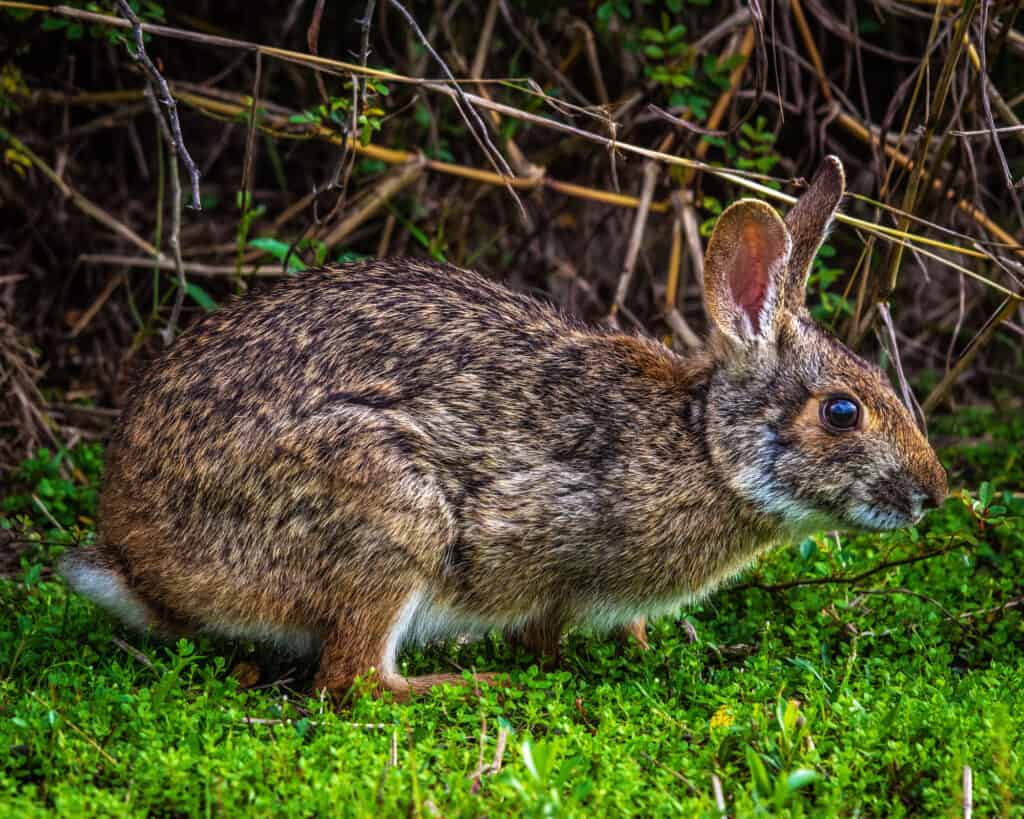Texas is well-known for its big animals, such as black bears and elk. However, not all the creatures in the state are large; some are on the smaller side, like wild rabbits. These adorable bunnies can be found hopping around all over the state. And if you know where to look, you might even see one yourself! Keep reading to discover more about wild rabbits in Texas and where you can find them.
What Wild Rabbits Live in Texas?
The wild rabbits that live in Texas include the desert cottontail, eastern cottontail, Davis Mountains cottontail, and swamp rabbit. The state’s also home to the large black-tailed jackrabbit, which is classified as a hare. The desert cottontails roam the western half of the state, while the swamp rabbit prefers the eastern side.
Desert Cottontail

Desert cottontails are sometimes called
prairie dog
rabbits because they use their burrows for shelter.
©Chris Hill/Shutterstock.com
Desert cottontails are abundant throughout Texas, living in grasslands, brush, and cactus deserts. They prefer short bushy vegetation, the kind where they can hide, but still easily survey the land. In the Trans-Pecos region, they like living in desert shrubs such as catclaw acacia and althorn. Sometimes they even climb trees to find shelter. In the plains region, they seek out prairie dog towns where so they can use the underground burrows as cover. This survival technique has earned them the name the “prairie dog rabbit”.
If you see one desert cottontail, you’ll likely see more! These rabbits are abundant throughout their range in West Texas. Although they usually come out at night, sometimes you can spot one hopping around during the day.
A rabbit on the move is usually a rabbit looking for food. In western Texas desert cottontails love eating leaves, grasses, twigs, and bark. As for what eats them, a few of the predators that target desert cottontails include foxes, barn owls, rattlesnakes, hawks, eagles, and great-horned owls.
Eastern Cottontail

Eastern cottontails are most active during twilight hours and nighttime.
©Rabbitti/Shutterstock.com
Another Texas resident is the Eastern cottontail, with long ears and a cotton white tail. These wild rabbits are most active at night when they forage for tasty grasses, fruits, and vegetables. As the weather turns cold, they rely on the bark and twigs of maple-leaf trees.
The cover of the night helps protect Eastern cottontails from the many predators who want to eat them. A few of their predators include foxes, rattlesnakes, bobcats, wolves, hawks, and owls. Skunks even occasionally dine on rabbits, especially if food sources are scarce.
Luckily for them, Eastern cottontail rabbits are incredibly fast, sometimes running up to 18 mph! These clever rabbits also use a zig-zag pattern to outmaneuver predators. Their survival skills help cottontails live as long as two years in the wild.
Eastern cottontails look almost identical to Texas’s swamp rabbit. One of the biggest differences is where they prefer to live. Cottontails prefer fields of tall grass, dense brush, and cactus desert. Whereas, swamp rabbits like swampy areas. Streams, wetlands, and creeks are all favorites of a swamp rabbit. Finally, black-tailed jackrabbits are easier to tell apart since they’re much larger than cottontails.
Davis Mountains Cottontail
One of the most elusive rabbits in Texas is the Davis Mountains cottontail species. These wild rabbits are native to the Trans-Pecos area of Texas. It’s believed their populations are extremely low, however, there’s currently not enough recent research to be sure.
Along with the mountains in West Texas, these rabbits also live in the neighboring mountains in Mexico and New Mexico. They prefer dense brush and pinyon-juniper woodlands.
Swamp Rabbit

Swamp rabbits prefer semi-aquatic habitats and are known to swim.
©Lawrence Jefferson/Shutterstock.com
Swamp rabbits, sometimes called cane cutters, are a type of large cottontail rabbit. These shy rabbits love living in wet territories and can be found in the eastern third of Texas. The brush along the creek bottoms serves as the perfect cover from predators like the great horned owl. As for what they eat, these vegetarians prefer grass, twigs, tree seedlings, and bark.
Along with their big bodies, another thing that sets them apart is their swimming abilities. Swamp rabbits are one of the only rabbit species that willingly swim. Using their water-resistant coat swamp rabbits cross creeks and rivers with ease.
What’s the Biggest Wild Rabbit in Texas?
The largest wild rabbit in Texas isn’t a rabbit at all, but a hare. The huge 4 to 9-pound black-tailed jackrabbit loves roaming the desert scrub, brushlands, and prairies. These habitats make it easy for them to spot predators from afar. Instead of hiding from the threats, jackrabbits depend on their speed to get away. A healthy adult can reach speeds of 45 mph!
Hare vs. Rabbit: What’s the Difference?
What’s the difference between a hare vs. rabbit? Hares are much larger, like living alone, and prefer rougher foods. While a rabbit might dine on grasses and soft stems, a hare’s more likely to chow down on some bark or twigs. Other differences include things like preferred nesting sites, habitats, gestation periods, and their experiences as babies. Rabbits are usually born blind and helpless, while hares enter the world with some nice warm fur and open eyes.
What to Do if You Find a Baby Rabbit in Texas
What should you do if you find a baby rabbit? Should you try to put it back in its nest? The answer depends on the situation. If you find a newborn, there could be a nest nearby where you can renest it. Nests tend to be near a building or shelter and in a shallow hole. The nest will likely be lined with fur and dried grass. Gently place the baby in the nest, and come check on it the next day to see if it seems like the mother returned. You don’t have to worry about your scent keeping their mom away, she’ll just be happy to have her baby back.
Don’t pick up a small bunny to renest it until you know for sure it needs help. Sometimes what appears to be a newborn bunny is really a baby bunny who’s ready to start living independently. Baby cottontails start fending for themselves as young as three weeks old. At this time they’re roughly the size of a baseball or large orange. If you find a baby rabbit and need advice on what to do, visit Wild Rescue, Inc. for more information.
The photo featured at the top of this post is © Charles T. Peden/Shutterstock.com
Thank you for reading! Have some feedback for us? Contact the AZ Animals editorial team.







